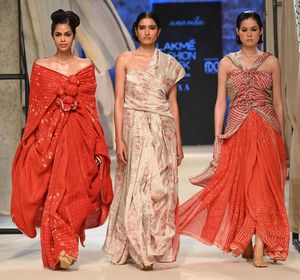Call me old fashioned, (but not old, please), but I am only too happy to have been to the FDCI and Lakme Fashion Week held in Mumbai last week. I thought I would make it for one or two shows during the now four-day event, but I went every day. I dressed up, I wore designer-loaned clothes, I sat in the front row, I had great cocktails and bad coffee, I air-kissed some celebrities, I posted cool stuff, I posted mean stuff. Fashion week, these days, is everything all at once.
I find that in these times of digital media and social media, the importance of traditional news-gathering is out of the window. Brands are creating their own narrative now. They don’t have to depend on a Vogue India or a Mumbai Mirror to feature them, they feature themselves on their Instagram pages for almost a million followers (or at least several thousands of them). Sales are now directly to consumers, either via their websites or via Facebook and Instagram. I know at least two dozen really cool labels that were born during the first lockdown and are already reasonably successful brands, dressing stars and all, only by showcasing on Instagram. Everyone is a star if they believe they are.
What is the point of a fashion week then? In the pre-digital world, these were hallowed events. Going to a fashion show was such a privilege. Front rows were lined with glamorous socialites matching Indian designer wear with international heels and handbags. Foreign buyers would flock to fashion weeks across the world to check out new designers and stock up on their merchandise, or then just visit a far-flung country on an all-expenses-paid trip. Journalists would be hounded to attend shows. After-parties were rambunctious, and after-after-parties were also a thing.
None of this exists anymore. Fashion weeks are put together on a string and prayer, mostly for the organising team to make some profit off the event. That may not be such a bad thing. The self-reliant, disorganised but still organised fashion business congregates at a fashion week. Buyers have been replaced by stylists, almost everyone is repping someone or the other. The designers from Delhi have had easy access to the Bollywood dressing scene, something they have secretly envied Mumbai for since decades. The cliquish FDCI would oust the Delhi lot if they appeared at the Mumbai week. Much of the old-world glamour is gone, but there are new tricks to learn. In these challenging times, designer labels need to either sink or swim.
After more than two years of staying home, or events being scaled down for fear of the virus—and then the rapidly sinking economy—it is finally reassuring to pretend to return to the times when things were better. Never mind that most of the clothes on the runway were laughable, the ones that were good were such a mood-fix (shout out to Tarun Tahiliani, Namrata Joshipura and Anavila for knocking it out of the park with their superbly done collections). Almost every other designer sent out shimmering cocktail wear, easy to do in India with cheap nets and sold-by-the-kilo sequins flooding the bazaars. It hurts the eyes, and I can’t even recall the names of the dozens who let India’s amazing artisanal styles down. But I am willing to hold my breath until our GDP is healthier again.
Fashion week is struggling to survive, just like many of us are. But while we are here, let’s put on a nice dress and play fabulous. Let’s remember the good times, and hope for them to return.
@namratazakaria


